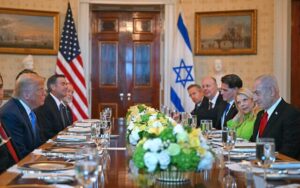
The National Interest Foundation Newsletter
Issue 292, July 11, 2025
Welcome to our NIF Newsletter. In this week’s edition, we examine Israeli Prime Minister Netanyahu’s visit to the United States and the prospects of a ceasefire in Gaza, and also delve into how while the United States lifts sanctions on Syria it continues pressuring the government in Damascus to join the Abraham Accords.
Editor: Bassam Tarbush
Netanyahu’s Visit to the United States and the Prospects of a Ceasefire in Gaza

The trip this week marks the third that Netanyahu has made to the White House since Trump returned to office. (Photo from AFP)
Israeli Prime Minister Benjamin Netanyahu’s latest visit to the United States this week has come amid ongoing indirect talks between Israel and Hamas in Qatar that have renewed hopes regarding the possibility of a new Gaza ceasefire deal. U.S. President Donald Trump has stepped up pressure on Israel and Hamas to reach an agreement, pushing both sides for a breakthrough in the now 21-month-long Gaza War due to what is seen by many as a clear desire to live up to his pledge to be a “peacemaker” and bring an end to the longstanding conflict. In fact, the evident optics behind the gathering of U.S. and Israeli officials at the White House was on full display. During a dinner meeting on Monday, Netanyahu gave Trump a letter that he said had been used to nominate the American president for the Nobel Peace Prize. Trump has made it no secret that he is seeking a Nobel, while Netanyahu is keen on trying to portray himself as being in the good graces of Trump. At the same get-together, the two leaders also again touted the widely denounced proposal to forcibly transfer Palestinians out of the Gaza Strip – something that has been universally condemned by the United Nations, human rights organizations, and governments across the world. These various entities have outlined that such action is strictly prohibited under international law and tantamount to ethnic cleansing.
Analysts have described a sense of cautious optimism regarding the prospects of a ceasefire, with it being unclear whether key obstacles can be overcome. For months, in the time since Israel reneged on a promise to engage in negotiations to implement the agreed-upon second phase of the January ceasefire, resumed hostilities in mid-March, and in doing so violated the terms of the previous agreement, efforts to reach a new deal have been hindered by Israel’s refusal to commit to a permanent end to the war. Hamas has repeatedly expressed that it will not release the remaining hostages without assurances of this, and as such, has sought to secure U.S. guarantees on bringing the war to an end (by proposing stronger language to ensure that the initial 60-day truce be extended indefinitely until an agreement is reached on permanently ending the war), in addition to clarifying the timeline and locations for the withdrawal of Israeli troops from Gaza. Key sticking points also exist over the distribution of humanitarian aid, with Hamas demanding an end to operations by the controversial and highly criticized Gaza Humanitarian Foundation (GHF), and a return instead to the United Nations and its partners overseeing all relief efforts. Just last week, more than 170 charities and non-governmental organizations (NGOs) called for the aid distribution takeover to be shut down.
Following their gathering on Monday, Trump and Netanyahu met again on Tuesday to further discuss the situation in Gaza. Prior to this, U.S. envoy Steve Witkoff had suggested that the issues keeping Israel and Hamas from reaching an agreement had dropped from four to one, with the remaining difference being related to the nature of Israeli forces’ withdrawal from the Palestinian territory. The Tuesday meeting concluded, however, without any public announcement of a breakthrough in the ongoing ceasefire and hostage release talks. While he still expressed plans to do so, it was also revealed that Witkoff had delayed his flight to Qatar to meet with mediators, with the decision to push back the trip leading observers to suspect that a significant amount of progress still needed to be made regarding the talks.
Even as there are still believed to be gaps in the negotiations, certain recent developments have raised hopes that momentum may be gathering towards a possible deal. Some outlets have reported that discussions were held at the White House earlier this week aimed at addressing the purported major remaining sticking point concerning the lines to which Israeli forces would withdraw under the prospective agreement, with this resulting in headway being made. This came after U.S. and Qatari officials compelled Israeli negotiators to amend their proposed redeployment map to consist of a wider troop withdrawal, calling the previously presented one including Israeli occupation of large parts of Gaza a “nonstarter” which was also labelled a “no-go” for the Trump administration. The new map put forth seems to have created a sense that it had increased the chances of a deal as Gaza ceasefire talks carry on. Still, mediators have cautioned that an agreement could yet take time to materialize.
While the U.S. Lifts Sanctions on Syria It Continues Pressuring the Government in Damascus to Join the Abraham Accords

The removal of U.S. sanctions has been greatly welcomed, but there are questions about the underlying nature of the move. (Photo from Getty Images)
Last week, President Donald Trump signed an executive order formally terminating most U.S. sanctions against Syria, following through on a pledge to do so made back in mid-May. The action did not rescind sanctions imposed on ousted former despot Bashar al-Assad, his top aides, family members, and officials who had been determined to have committed egregious human rights abuses. Advocates had long been pushing for the removal of sanctions on Syria due to its crippling effect on the country’s population, and these arguments only gained further traction following the overthrowing of the Assad regime back in early December of 2024. As such, the lifting of sanctions has been welcomed as a positive step forward which provides the Syrian transitional government an opportunity to stabilize the country and initiate much-needed reconstruction, as well as social, humanitarian, and economic recovery efforts. While this is undoubtedly the case, there are also questions, however, regarding the underlying nature of the move and what may be expected in return. Some analysts have alluded to what they see as a “carrot-and-stick” form of policy whereby the Trump administration may have implemented the sanctions removal as a means of pressuring the new government in Damascus to take certain actions such as potentially joining the Abraham Accords.
In making this case, various observers have pointed to the apparent willingness of Syrian officials to initiate Trump-desired moves in order to secure U.S. sanctions relief. In fact, during last week’s announcement of the executive order to officially lift the sanctions, the White House even remarked that the Trump administration would continue to monitor Syria’s progress on key priorities including, among others, “taking concrete steps toward normalizing ties with Israel.” Syrian leaders also appear to have offered Trump other incentives to secure sanctions removal like the proposal to build a Trump tower in Syria’s capital city of Damascus. To a significant number of experts and commentators, all of this signals that sanctions removal may have been a conditional move in which the new Syrian government was rewarded for its readiness to act in line with numerous interests of the Trump administration.
This perception aligns with reports that discussions could be taking place regarding a potential security agreement between Syria and Israel in the coming months, something that Trump officials seem keen on as a means of laying the foundation for possible future normalization. However, while there are suggestions that Syrian officials have shown openness to engaging with Israel, they have also indicated that joining the Abraham Accords would require certain conditions to be met – major points of contention of which are Israel’s continued illegal occupation of the Golan Heights, its further recent land incursions, and numerous attacks against Syria since the fall of the Assad regime. The Trump administration’s approach seems to be based on the idea of enticing Syria economically, but it does not account for the new Damascus government’s weariness to join on to the Abraham Accords due to the lack of public support for this type of move and the fact that it would likely undermine its legitimacy among the population. Many Syrians are opposed to the idea under the current circumstances as a result of Israel’s repeated violations, belligerence, and aggression in Syria and across the region as a whole, and therefore, there is a fear that normalization could plunge the country back into instability – a factor not lost on the new Syrian government.
While the motivations behind the move are questionable, the benefits of the lifting of sanctions are clear. Over the preceding decades, these debilitating punitive measures have resulted in major shortages of essential goods like food, electricity, fuel, and medical equipment. They have also hindered the ability of humanitarian agencies to receive funding and operate due to the ongoing restrictions regarding financial transactions, investment, and international trade. The sanctions have been directly linked to the severe economic hardship in the country, as an estimated 90% of the Syrian population faces food insecurity. It is hoped that the lifting of U.S. sanctions will alleviate this issue and increase the flow of goods into Syria, providing the country and its new government – which is currently navigating a delicate political transition – greater access to the global economy, aid, and international financial systems at this vital stage in time, in addition to helping it stabilize the nation and prevent descent into disorder. Furthermore, it should create opportunities for economic, societal, and humanitarian development, allowing Syria to attract the foreign investment needed in order to rebuild infrastructure devastated by years of conflict and oppression at the hands of the previous Assad regime.
